Effects of Anaerobic Soil Disinfestation for Soilborne Disease and Weed Management on Baby Leaf Lettuce Performance in a High Tunnel Organic Production System
Abstract
:1. Introduction
2. Materials and Methods
2.1. Field Experiments
2.2. Lettuce Cultivars
2.3. Environmental Conditions and Sensor Installation
2.4. Determination of Soil pH
2.5. Disease Scouting and Weed Assessment
2.6. Crop Yield and Biometric Measurements
2.7. Determination of Lettuce Quality Attributes
2.8. Statistical Analysis
3. Results
3.1. Soil Oxidation–Reduction Potential and Environmental Conditions
3.2. Soil Treatment Impacts on Soil pH
3.3. Soil Treatment Impacts on Disease Incidence and Weed Population Density
3.4. Soil Treatment Impacts on Crop Yield and Biometrics
3.5. Lettuce Quality Attributes
4. Discussion
4.1. Soil and Environmental Conditions
4.2. ASD Soil Treatment Impacts on Disease and Weed Suppression
4.3. ASD Soil Treatment and Lettuce Cultivar Impacts on Crop Performance and Leaf Quality Attributes
5. Conclusions
Author Contributions
Funding
Data Availability Statement
Acknowledgments
Conflicts of Interest
References
- Lamont, W.J. Overview of the use of high tunnels worldwide. HortTechnology 2009, 19, 25–29. [Google Scholar] [CrossRef]
- Carey, E.E.; Jett, L.; Lamont, W.J.; Nennich, T.T.; Orzolek, M.D.; Williams, K.A. Horticultural crop production in high tunnels in the United States: A snapshot. HortTechnology 2009, 19, 37–43. [Google Scholar] [CrossRef]
- Janke, R.R.; Altamimi, M.E.; Khan, M. The use of high tunnels to produce fruit and vegetable crops in North America. Agric. Sci. 2017, 8, 692–715. [Google Scholar] [CrossRef]
- Hochmuth, R.C.; Toro, D.E. Characterization of the Florida Fresh Fruit and Vegetable Industry Using Hydroponic Systems or Protected Agriculture Structures. Available online: https://edis.ifas.ufl.edu/publication/HS1240 (accessed on 29 August 2023).
- Cultiva Farms USA Completes Next Phase of Multi-Million Dollar Expansion in Jennings. Available online: https://www.hamiltoncda.org/news/cultiva-farms-usa-completes-next-phase-of-multi-million-dollar-expansion-in-jennings/ (accessed on 29 August 2023).
- Donovan, M.; Ruiz-Menjivar, J.; Coolong, T.; Swisher, M.E. A scientometric review of the peer-reviewed research on high tunnels in the United States. Renew. Agric. Food Syst. 2023, 38, e48. [Google Scholar] [CrossRef]
- Sanabria-Valazques, A.D.; Testen, A.L.; Khadka, R.B.; Liu, Z.; Xu, F.; Miller, S.A. Anaerobic soil disinfestation reduces viability of Sclerotinia sclerotiorum and S. minor sclerotia and root-knot nematodes in muck soils. Phytopathology 2020, 110, 795–804. [Google Scholar] [CrossRef]
- Lopes, E.A.; Canedo, E.J.; Gomes, V.A.; Vieira, B.S.; Parreira, D.F.; Neves, W.S. Anaerobic soil disinfestation for the management of soilborne pathogens: A review. Appl. Soil Ecol. 2022, 174, 104408. [Google Scholar] [CrossRef]
- Shrestha, U.; Augé, R.M.; Butler, D.M. A meta-analysis of the impact of anaerobic soil disinfestation on pest suppression and yield of horticultural crops. Front. Plant Sci. 2016, 7, 1254. [Google Scholar] [CrossRef]
- Priyashantha, A.H.; Attanayake, R.N. Can anaerobic soil disinfestation (ASD) be a game changer in tropical agriculture? Pathogens 2021, 10, 133. [Google Scholar] [CrossRef]
- Kreutz, G.F.; Sandoya, G.V.; England, G.K.; Mussoline, W. Exploring the potential of lettuce (Lactuca sativa) as an early crop in Florida’s sandy soils. HortScience 2021, 56, 59–70. [Google Scholar] [CrossRef]
- Rabenhorst, M.C.; Castenson, K.L. Temperature effects on iron reduction in a hydric soil. Soil Sci. 2005, 170, 734–742. [Google Scholar] [CrossRef]
- Benzie, I.F.F.; Strain, J.J. The ferric reducing ability of plasma (FRAP) as a measure of “antioxidant power”: The FRAP assay. Anal. Biochem. 1996, 239, 70–76. [Google Scholar] [CrossRef]
- Inglett, P.W.; Reddy, K.R.; Corstanje, R. Anaerobic Soils. In Encyclopedia of Soils in the Environment; Elsevier: Amsterdam, The Netherlands, 2005; pp. 72–78. [Google Scholar]
- Li, B.; Zhou, J.; Lu, Y.; Xiong, Z. Field-aged biochar reduces the greenhouse gas balance in a degraded vegetable field treated by reductive soil disinfestation. Environ. Sci. Pollut. Res. 2019, 26, 10609–10620. [Google Scholar] [CrossRef] [PubMed]
- Di Gioia, F.; Ozores-Hampton, M.; Hong, J.C.; Kokalis-Burelle, N.; Albano, J.; Zhao, X.; Rosskopf, E.N. The effects of anaerobic soil disinfestation on weed and nematode control, fruit yield, and quality of Florida fresh-market tomato. HortScience 2016, 51, 703–711. [Google Scholar] [CrossRef]
- Guo, H.; Di Gioia, F.; Zhao, X.; Ozores-Hampton, M.; Swisher, M.E.; Hong, J.C.; Rosskopf, E.N. Optimizing anaerobic soil disinfestation for fresh market tomato production: Nematode and weed control, yield, and fruit quality. Sci. Hortic. 2017, 218, 105–116. [Google Scholar] [CrossRef]
- Di Gioia, F.; Ozores-Hampton, M.; Zhao, X.; Thomas, J.; Wilson, P.; Li, Z.; Rosskopf, E.N. Anaerobic soil disinfestation impact on soil nutrients dynamics and nitrous oxide emissions in fresh-market tomato. Agric. Ecosyst. Environ. 2017, 240, 194–205. [Google Scholar] [CrossRef]
- Shennan, C.; Muramoto, J.; Baird, G.; Cruz, S.; Daugovish, O.; Koike, S.; Bolda, M. Anaerobic soil disinfestation: California. Eur. J. Plant Pathol. 2011, 117, 403–415. [Google Scholar]
- Momma, N.; Yamamoto, K.; Simandi, P.; Shishido, M. Role of organic acids in the mechanisms of biological soil disinfestation (BSD). J. Gen. Plant Pathol. 2006, 72, 247–252. [Google Scholar] [CrossRef]
- Hewavitharana, S.S.; Klarer, E.; Reed, A.J.; Leisso, R.; Poirier, B.; Honaas, L.; Mazzola, M. Temporal dynamics of the soil metabolome and microbiome during simulated anaerobic soil disinfestation. Front. Microbiol. 2019, 10, 2365. [Google Scholar] [CrossRef] [PubMed]
- Rosskopf, E.N.; Di Gioia, F.; Hong, J.C.; Pisani, C.; Kokalis-Burelle, N. Organic amendments for pathogen and nematode control. Annu. Rev. Phytopathol. 2020, 58, 277–311. [Google Scholar] [CrossRef]
- Vecchia, L.; Di Gioia, F.; Ferrante, A.; Hong, J.C.; White, C.; Rosskopf, E.N. Integrating cover crops as a source of carbon for anaerobic soil disinfestation. Agronomy 2020, 10, 1614. [Google Scholar] [CrossRef]
- Mao, Y.; Hafeez, A.; Pan, T.; Wu, C.; Wang, L.; Muramoto, J.; Tian, J. Suppression of tomato bacterial wilt by anaerobic soil disinfestation and associations with production of antagonistic compounds. Plant Soil 2022, 477, 539–552. [Google Scholar] [CrossRef]
- Khadka, R.B.; Sanabria-Valazques, A.D.; Cardina, J.; Miller, S.A. Evaluation of anaerobic soil disinfestation for environmentally sustainable weed management. Agronomy 2022, 12, 3147. [Google Scholar] [CrossRef]
- Claerbout, J.; Decombel, A.; Volckaert, A.; Venneman, S.; Vandevelde, I.; Bleyaert, P.; Höfte, M. Glasshouse-specific occurrence of basal rot pathogens and the seasonal shift of Rhizoctonia solani anastomosis groups in lettuce. Eur. J. Plant Pathol. 2019, 155, 841–858. [Google Scholar] [CrossRef]
- Van Beneden, S.; Pannecoucque, J.; Debode, J.; De Backer, G.; Höfte, M. Characterization of fungal pathogens causing basal rot of lettuce in Belgian greenhouses. Eur. J. Plant Pathol. 2009, 124, 9–19. [Google Scholar] [CrossRef]
- Ritchie, F.; Bain, R.A.; McQuilken, M.P. Effects of nutrient status, temperature, and pH on mycelial growth, sclerotial production and germination of Rhizoctonia solani from potato. J. Plant Pathol. 2009, 91, 589–596. [Google Scholar]
- Snyder, L.; Schonbeck, M.; Velez, T.; Tencer, B. 2022 National Organic Research Agenda Outcomes and Recommendations from the 2020 National Organic & Transitioning Farmer Surveys and Focus Groups; Organic Farming Research Foundation: Santa Cruz, CA, USA, 2022. [Google Scholar]
- Liu, D.; Samtani, J.B.; Johnson, C.S.; Butler, D.M.; Derr, J. Weed control assessment of various carbon sources for anaerobic soil disinfestation. Int. J. Fruit Sci. 2020, 20, 1005–1018. [Google Scholar] [CrossRef]
- Shrestha, U.; Rosskopf, E.N.; Butler, D.M. Effect of anaerobic soil disinfestation amendment type and C: N ratio on Cyperus esculentus tuber sprouting, growth and reproduction. Weed Res. 2018, 58, 379–388. [Google Scholar] [CrossRef]
- Muramoto, J.; Shennan, C.; Fitgerald, A.; Koike, S.; Bold, M.; Daugovish, O.; Butler, D.M. Effect of Anaerobic Soil Disinfestation on Weed Seed Germination. In Proceedings of the Annual International Research Conference on Methyl Bromide Alternatives and Emissions Reductions, San Diego, CA, USA, 14–16 November 2007. [Google Scholar]
- Greenwood, D.J. The effect of oxygen concentration on the decomposition of organic materials in soil. Plant Soil 1961, 14, 360–376. [Google Scholar] [CrossRef]
- McCarty, D.G.; Inwood, S.E.E.; Ownley, B.H.; Sams, C.E.; Wszelaki, A.L.; Butler, D.M. Field evaluation of carbon sources for anaerobic soil disinfestation in tomato and bell pepper production in Tennessee. HortScience 2014, 49, 272–280. [Google Scholar] [CrossRef]
- Khadka, R.B.; Cardina, J.; Miller, S.A. Perspectives on anaerobic soil disinfestation for weed management. J. Integr. Pest Manag. 2021, 12, 32. [Google Scholar] [CrossRef]
- Jiang, Y.; Kang, Y.; Han, C.; Zhu, T.; Deng, H.; Xie, Z.; Zhong, W. Biochar amendment in reductive soil disinfestation process improved remediation effect and reduced N2O emission in nitrate-riched degraded soil. Arch. Agron. Soil Sci. 2020, 66, 983–991. [Google Scholar] [CrossRef]
- Huang, X.; Lui, L.; Wen, T.; Zhang, J.; Shen, Q.; Cai, Z. Reductive soil disinfestations combined or not with Trichoderma for the treatment of a degraded and Rhizoctonia solani infested greenhouse soil. Sci. Hortic. 2016, 206, 51–61. [Google Scholar] [CrossRef]
- Muramoto, J.; Shennan, C.; Zavatta, M.; Baird, G.; Toyama, L.; Mazzola, M. Effect of anaerobic soil disinfestation and mustard seed meal for control of charcoal rot in California strawberries. Int. J. Fruit Sci. 2016, 16, 59–70. [Google Scholar] [CrossRef]
- Khadka, R.B.; Marasini, M.; Rawal, R.; Testen, A.L.; Miller, S.A. Effects of anaerobic soil disinfestation carbon sources on soilborne diseases and weeds of okra and eggplant in Nepal. Crop Prot. 2020, 135, 104846. [Google Scholar] [CrossRef]
- Donahoo, T.; Zhang, L.; Cutulle, M.; Hajihassani, A. Economic analysis of grafting and anaerobic soil disinfestation for tomato production in South Carolina. HortTechnology 2021, 31, 615–624. [Google Scholar] [CrossRef]
- DuPont, S.T.; Hewavitharana, S.S.; Mazzola, M. Field scale application of Brassica seed meal and anaerobic soil disinfestation for the control of apple replant disease. Appl. Soil Ecol. 2021, 166, 104076. [Google Scholar] [CrossRef]
- Mowlick, S.; Yasukawa, H.; Inoue, T.; Takehara, T.; Kaku, N.; Ueki, K.; Ueki, A. Suppression of spinach wilt disease by biological soil disinfestation incorporated with Brassica juncea plants in association with changes in soil bacterial communities. Crop Prot. 2013, 54, 185–193. [Google Scholar] [CrossRef]
- Testen, A.L.; Miller, S.A. Anaerobic soil disinfestation to manage soilborne diseases in muck soil vegetable production systems. Plant Dis. 2019, 103, 1757–1762. [Google Scholar] [CrossRef]
- Gilardi, G.; Pugliese, M.; Gullino, M.L.; Garibaldi, A. Evaluation of different carbon sources for anaerobic soil disinfestation against Rhizoctonia solani on lettuce in controlled production systems. Phytopathol. Mediterr. 2020, 59, 77–96. [Google Scholar] [CrossRef]
- Selma, M.V.; Luna, M.C.; Martínez- Sánchez, A.; Tudela, J.A.; Beltrá, D.; Baixauli, C.; Gil, M.I. Sensory quality, bioactive constituents, and microbiological quality of green and red fresh-cut lettuces (Lactuca sativa L.) are influenced by soil and soilless agricultural production systems. Postharvest Biol. Technol. 2012, 63, 16–24. [Google Scholar] [CrossRef]
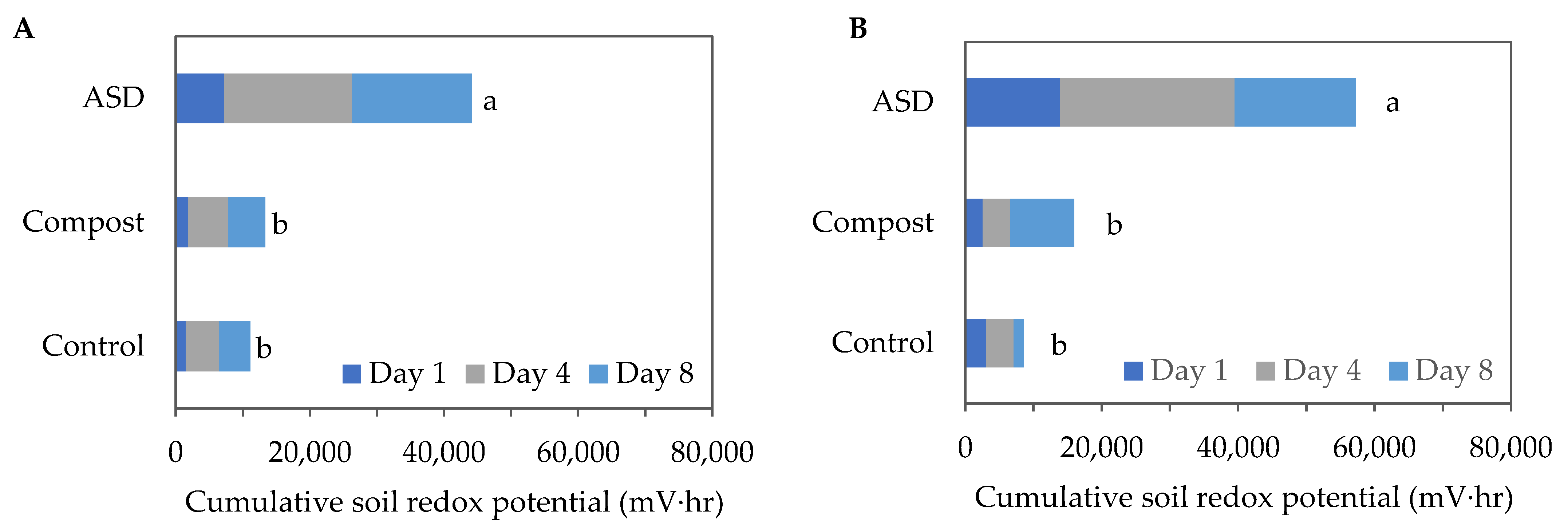

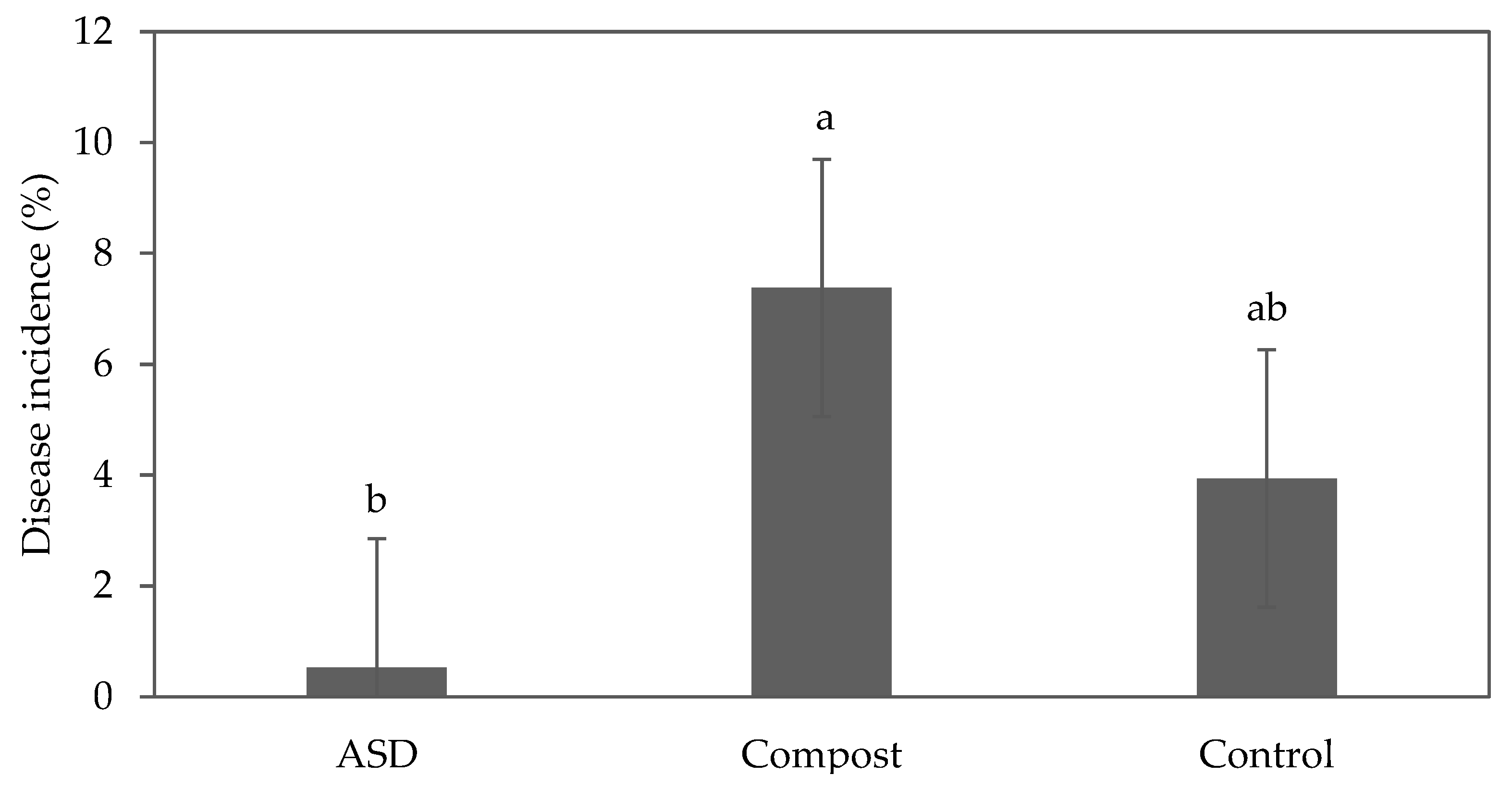
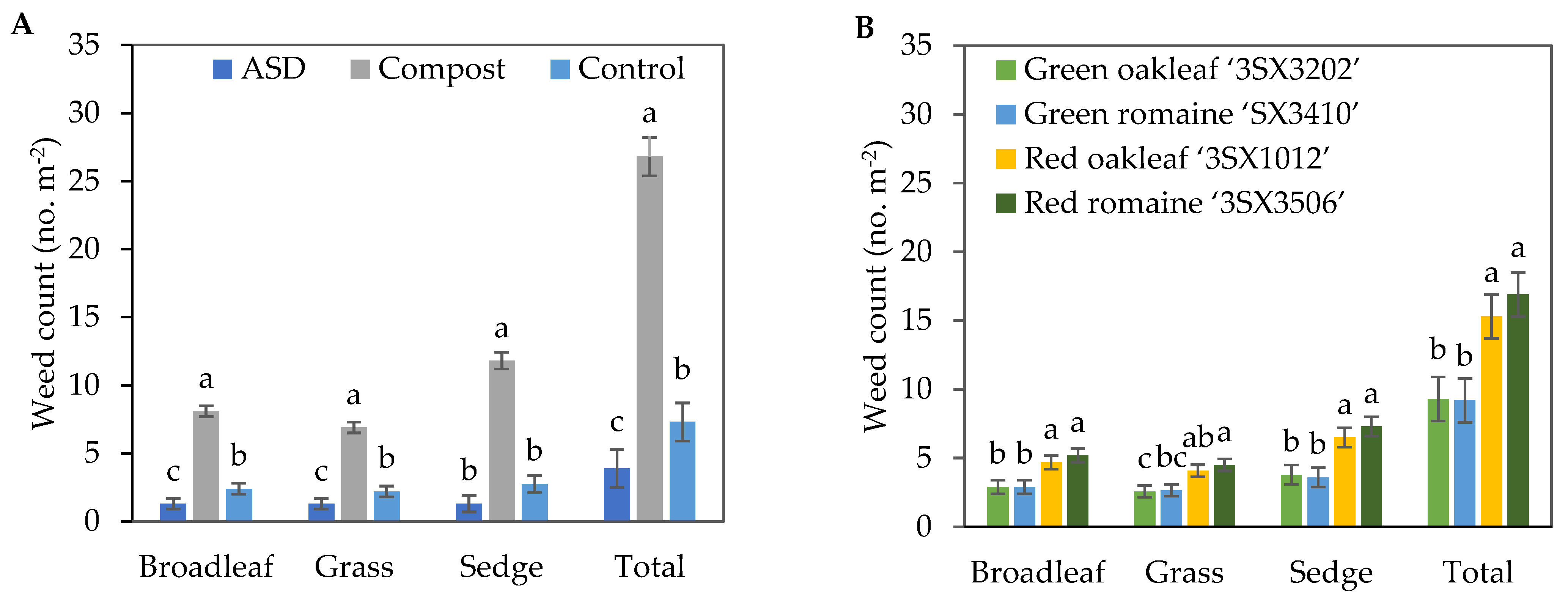
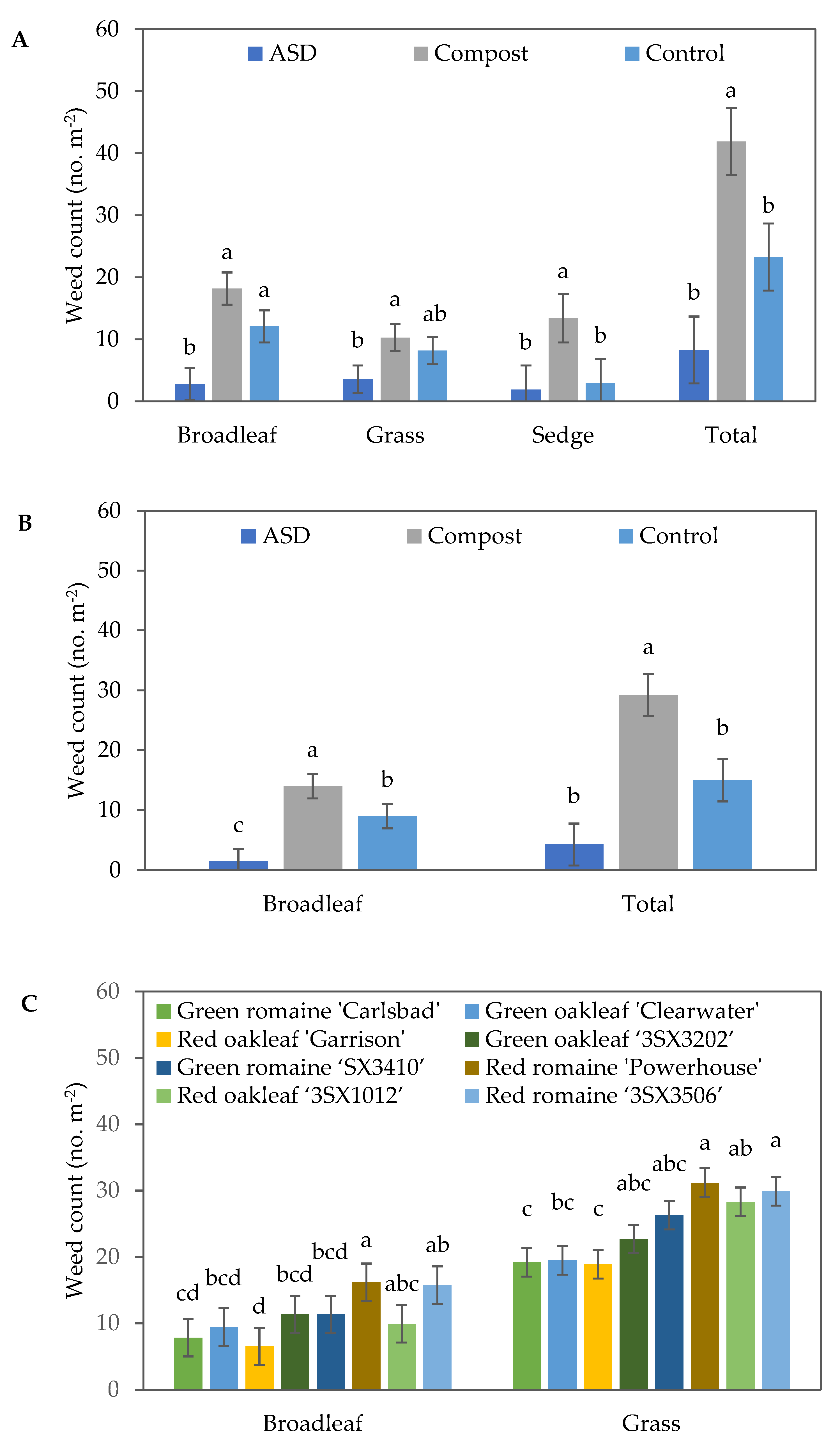
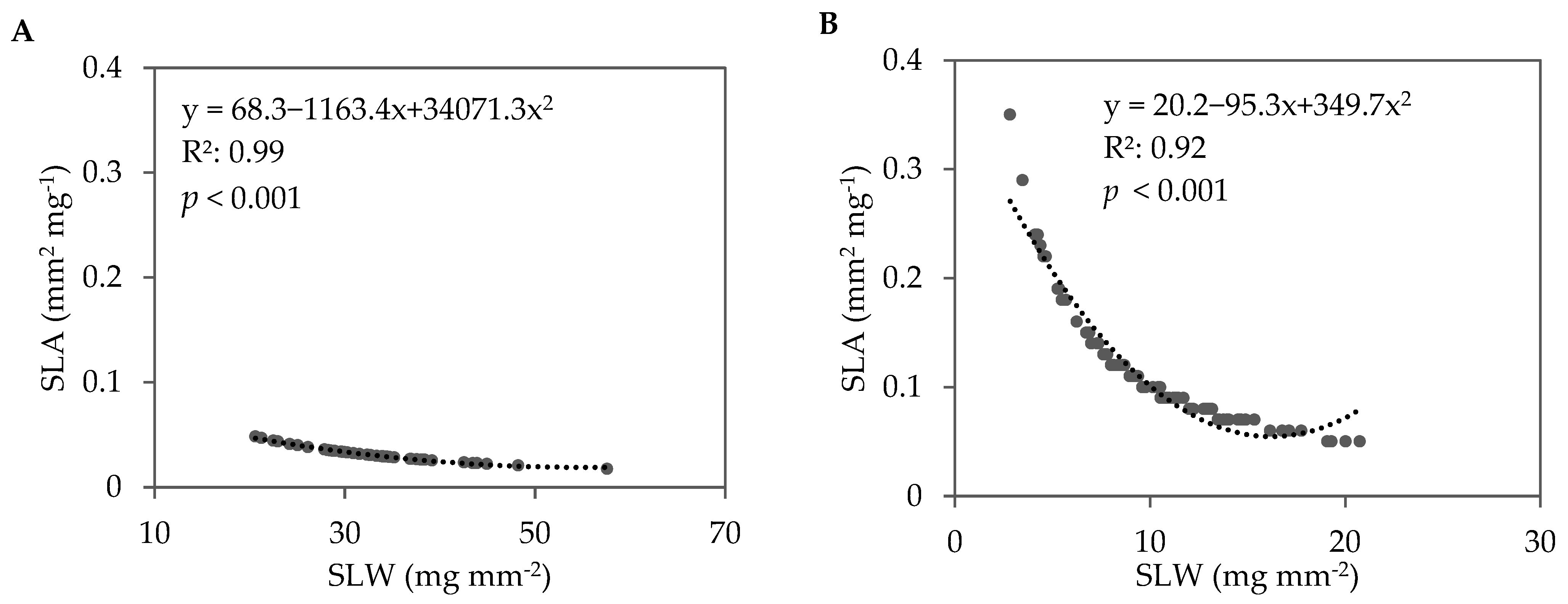
| Effect | Fall 2021 | Spring 2022 |
|---|---|---|
| Soil Treatment (T) | *** | NS |
| Sampling date (DAT) | *** | NS |
| T × DAT | *** | NS |
| Days after ASD Treatment Application | |||
|---|---|---|---|
| Soil Treatment | 0 (Baseline) | 1 | 8 |
| ASD | 7.9 Aa | 5.9 Bb | 5.7 Cb |
| Compost | 7.9 Aa | 7.3 Ab | 7.3 Bb |
| Control | 7.9 Aa | 7.2 Ab | 7.9 Aa |
| Fall 2021 | ||||||||
|---|---|---|---|---|---|---|---|---|
| Broadleaf | Grass | Sedge | Total | |||||
| 7 DAS | 40 DAS | 7 DAS | 40 DAS | 7 DAS | 40 DAS | 7 DAS | 40 DAS | |
| Soil treatment (T) | NS | *** | NS | *** | NS | *** | NS | *** |
| Cultivar (C) | NS | *** | NS | ** | NS | ** | NS | ** |
| T × C | NS | NS | NS | NS | NS | NS | NS | NS |
| Spring 2022 | ||||||||
| Broadleaf | Grass | Sedge | Total | |||||
| 7 DAS | 27 DAS | 7 DAS | 27 DAS | 7 DAS | 27 DAS | 7 DAS | 27 DAS | |
| Soil treatment (T) | ** | ** | NS | NS | NS | * | ** | ** |
| Cultivar (C) | NS | ** | NS | NS | NS | NS | NS | * |
| T × C | NS | NS | NS | NS | NS | NS | NS | NS |
| Fall 2021 | ||||
|---|---|---|---|---|
|
Fresh Weight
(g m−2) |
LDMC z (%) |
SLA y (mm2 mg−1) |
SLW x (mg mm−2) | |
| Soil treatment (S) | ||||
| ASD | 639.5 | 6.1 | 36.1 a | 0.029 b |
| Compost | 396.9 | 6.8 | 32.8 b | 0.032 a |
| Control | 315.5 | 6.9 | 31.1 b | 0.033 a |
| Cultivar (C) | ||||
| Green oakleaf ‘3SX3202’ | 584.6 a | 6.6 a | 27.7 c | 0.037 a |
| Green romaine ‘SX3410’ | 474.8 ab | 5.7 b | 31.7 bc | 0.032 b |
| Red oakleaf ‘3SX1012’ | 417.0 b | 7.1 a | 34.5 b | 0.030 bc |
| Red romaine ‘3SX3506’ | 326.1 b | 7.0 a | 39.3 a | 0.026 c |
| S | NS | NS | * | * |
| C | ** | ** | *** | * |
| S × C | NS | NS | NS | NS |
| Spring 2022 | ||||
| Soil treatment (S) | ||||
| ASD | 1654.8 | 5.9 | 11.3 | 0.102 |
| Compost | 1110.4 | 6.0 | 9.3 | 0.137 |
| Control | 1345.1 | 5.9 | 10.3 | 0.102 |
| Cultivar (C) | ||||
| Green romaine ‘Carlsbad’ | 1871.2 a | 4.8 c | 10.8 abc | 0.111 abc |
| Green oakleaf ‘Clearwater’ | 1414.8 b | 6.3 b | 12.2 a | 0.100 bc |
| Red oakleaf ‘Garrison’ | 1652.3 ab | 5.3 c | 12.6 a | 0.086 c |
| Green oakleaf ‘3SX3202’ | 1714.2 ab | 5.2 c | 9.8 bcd | 0.112 abc |
| Green romaine ‘SX3410’ | 1626.7 ab | 5.3 c | 11.3 ab | 0.098 bc |
| Red romaine ‘Powerhouse’ | 960.5 c | 6.4 ab | 9.0 cd | 0.122 ab |
| Red oakleaf ‘3SX1012’ | 975.4 c | 7.0 ab | 8.4 d | 0.142 a |
| Red romaine ‘3SX3506’ | 745.9 c | 7.2 a | 8.3 d | 0.142 a |
| S | NS | NS | NS | NS |
| C | *** | *** | ** | ** |
| S × C | NS | NS | NS | NS |
| Fall 2021 | |||||
|---|---|---|---|---|---|
| a* | b* | C* | H* | L* | |
| Soil treatment (S) | |||||
| ASD | −4.9 | 12.0 | 15.9 | 114.7 | 34.2 |
| Compost | −4.6 | 12.8 | 16.3 | 76.4 | 34.9 |
| Control | −4.6 | 12.3 | 16.2 | 88.3 | 34.0 |
| Cultivar (C) | |||||
| Green oakleaf ‘3SX3202’ | −14.8 c | 23.1 a | 27.4 a | 1.22.8 a | 43.5 a |
| Green romaine ‘SX3410’ | −13.1 b | 21.4 a | 25.1 b | 121.7 a | 43.0 a |
| Red oakleaf ‘3SX1012’ | 5.0 a | 3.1 b | 6.6 c | 38.2 b | 26.4 b |
| Red romaine ‘3SX3506’ | 4.2 a | 1.8 b | 5.4 c | 90.1 b | 25.1 b |
| S | NS | NS | NS | NS | NS |
| C | *** | *** | *** | *** | *** |
| S × C | NS | NS | NS | NS | NS |
| Soil treatment (S) | Spring 2022 | ||||
| ASD | −4.8 | 11.9 | 15.9 | 116.3 a | 34.0 |
| Compost | −4.7 | 12.8 | 16.3 | 76.2 b | 34.9 |
| Control | −4.5 | 12.2 | 16.1 | 89.2 ab | 34.0 |
| Cultivar (C) | |||||
| Green romaine ‘Carlsbad’ | −13.0 b | 21.4 a | 25.0 b | 121.4 ab | 43.2 a |
| Green oakleaf ‘Clearwater’ | −15.1 d | 23.1 a | 27.6 a | 123.3 a | 42.3 a |
| Red oakleaf ‘Garrison’ | 4.9 a | 3.2 b | 6.6 c | 27.7 c | 26.4 b |
| Green oakleaf ‘3SX3202’ | −14.6 cd | 23.1 a | 27.3 ab | 122.4 a | 43.4 a |
| Green romaine ‘SX3410’ | −13.1 bc | 21.4 a | 25.1 ab | 121.5 ab | 43.0 a |
| Red romaine ‘Powerhouse’ | 4.2 a | 1.3 b | 4.8 c | 118.2 ab | 24.2 b |
| Red oakleaf ‘3SX1012’ | 5.0 a | 2.9 b | 6.5 c | 45.3 bc | 26.5 b |
| Red romaine ‘3SX3506’ | 4.1 a | 2.2 b | 5.8 c | 71.3 abc | 25.6 b |
| S | NS | NS | NS | * | NS |
| C | *** | *** | *** | *** | *** |
| S × C | NS | NS | NS | NS | NS |
| SSC z (°Brix) | TTA y (% Citric Acid) | FRAP x (mmol TE 100 g−1 FW) | TPC w (mg 100 g−1 FW) | AA v (mg 100 g−1 FW) | |
|---|---|---|---|---|---|
| Fall 2021 | |||||
| Soil treatment (S) | |||||
| ASD | 2.9 | 0.08 | 68.1 | 44.8 | 43.0 |
| Compost | 3.2 | 0.08 | 60.7 | 47.5 | 40.0 |
| Control | 3.1 | 0.08 | 76.9 | 54 | 40.8 |
| Cultivar (C) | |||||
| Green oakleaf ‘3SX3202’ | 3.4 a | 0.08 b | 34.8 b | 30.8 b | 29.4 b |
| Green romaine ‘SX3410’ | 2.7 c | 0.07 c | 11.2 c | 15.0 c | 18.2 c |
| Red oakleaf ‘3SX1012’ | 3.0 b | 0.09 a | 116.5 a | 81.2 a | 60.3 a |
| Red romaine ‘3SX3506’ | 3.0 bc | 0.09 a | 111.2 a | 68.2 a | 57.2 a |
| S | NS | NS | NS | NS | NS |
| C | *** | *** | *** | *** | *** |
| S × C | NS | NS | NS | NS | NS |
| Spring 2022 | |||||
| Soil treatment (S) | |||||
| ASD | 2.7 | 0.10 | 85.5 | - u | 78.2 |
| Compost | 2.7 | 0.09 | 85.9 | - | 76.8 |
| Control | 2.6 | 0.08 | 87.3 | - | 76.1 |
| Cultivar (C) | |||||
| Green romaine ‘Carlsbad’ | 2.7 | 0.08 b | 27.3 c | - | 17.7 c |
| Green oakleaf ‘Clearwater’ | 2.6 | 0.10 ab | 77.5 b | - | 54.5 b |
| Red oakleaf ‘Garrison’ | 2.7 | 0.09 ab | 117.0 a | - | 134.9 a |
| Green oakleaf ‘3SX3202’ | 2.7 | 0.10 ab | 77.3 b | - | 54.5 b |
| Green romaine ‘SX3410’ | 2.6 | 0.08 b | 28.1 c | - | 17.2 c |
| Red romaine ‘Powerhouse’ | 2.6 | 0.09 ab | 122.1 a | - | 93.7 a |
| Red oakleaf ‘3SX1012’ | 2.8 | 0.09 ab | 115.0 a | - | 124.7 a |
| Red romaine ‘3SX3506’ | 2.7 | 0.10 a | 123.9 a | - | 107.9 a |
| S | NS | NS | NS | ** | NS |
| C | NS | *** | *** | *** | *** |
| S × C | NS | NS | NS | *** | NS |
| Soil Treatment | |||
|---|---|---|---|
| Cultivar | ASD | Compost | Control |
| Green romaine ‘Carlsbad’ | 13.8 Ba | 15.1 Ba | 14.7 Ba |
| Green oakleaf ‘Clearwater’ | 49.1 Aa | 31.3 Bab | 24.6 Bb |
| Red oakleaf ‘Garrison’ | 56.8 Ab | 83.3 Aa | 51.6 Ab |
| Green oakleaf ‘3SX3202’ | 48.2 Aa | 32.7 Bab | 27.7 Bb |
| Green romaine ‘SX3410’ | 14.2 Ba | 15.6 Ba | 15.1 Ba |
| Red romaine ‘Powerhouse’ | 58.3 Ab | 75.4 Aa | 48.2 Ab |
| Red oakleaf ‘3SX1012’ | 56.8 Ab | 83.3 Aa | 51.6 Ab |
| Red romaine ‘3SX3506’ | 66.4 Aa | 70.7 Aa | 61.7 Aa |
Disclaimer/Publisher’s Note: The statements, opinions and data contained in all publications are solely those of the individual author(s) and contributor(s) and not of MDPI and/or the editor(s). MDPI and/or the editor(s) disclaim responsibility for any injury to people or property resulting from any ideas, methods, instructions or products referred to in the content. |
© 2024 by the authors. Licensee MDPI, Basel, Switzerland. This article is an open access article distributed under the terms and conditions of the Creative Commons Attribution (CC BY) license (https://creativecommons.org/licenses/by/4.0/).
Share and Cite
Vincent, I.R.; Rosskopf, E.N.; Brecht, J.K.; Dufault, N.S.; Sandoya-Miranda, G.; Zhao, X. Effects of Anaerobic Soil Disinfestation for Soilborne Disease and Weed Management on Baby Leaf Lettuce Performance in a High Tunnel Organic Production System. Agronomy 2024, 14, 764. https://doi.org/10.3390/agronomy14040764
Vincent IR, Rosskopf EN, Brecht JK, Dufault NS, Sandoya-Miranda G, Zhao X. Effects of Anaerobic Soil Disinfestation for Soilborne Disease and Weed Management on Baby Leaf Lettuce Performance in a High Tunnel Organic Production System. Agronomy. 2024; 14(4):764. https://doi.org/10.3390/agronomy14040764
Chicago/Turabian StyleVincent, Isaac R., Erin N. Rosskopf, Jeffrey K. Brecht, Nicholas S. Dufault, Germán Sandoya-Miranda, and Xin Zhao. 2024. "Effects of Anaerobic Soil Disinfestation for Soilborne Disease and Weed Management on Baby Leaf Lettuce Performance in a High Tunnel Organic Production System" Agronomy 14, no. 4: 764. https://doi.org/10.3390/agronomy14040764






